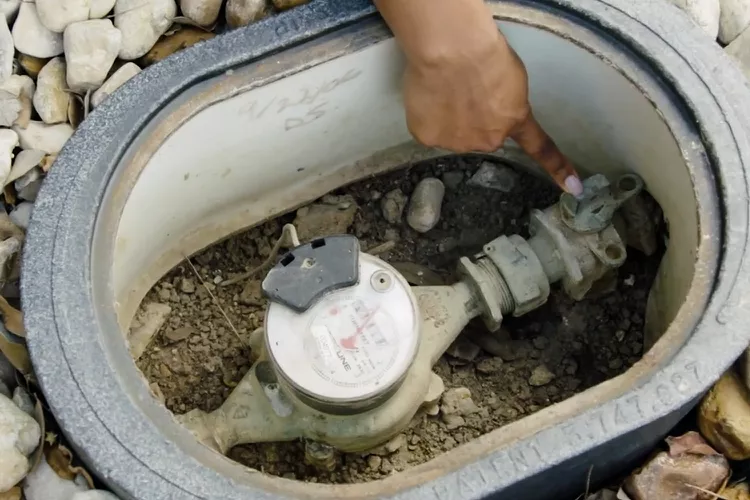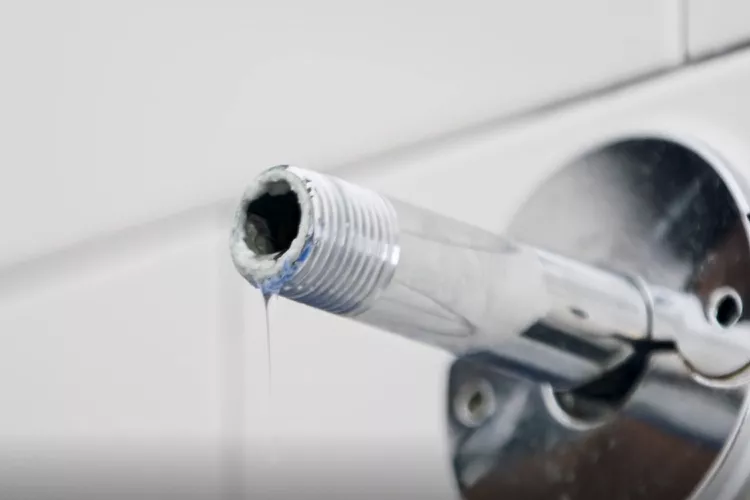When there is a problem with low water pressure in your house, it’s important to figure out the reason and how to fix it. In order to fix low water pressure problems, it’s necessary to determine what is causing the trouble in the first place.
Use this guide to discover 10 reasons for low water pressure in your house and how to resolve the situation.

Identifying Low Water Pressure Problems
If you suspect that there is a water pressure problem or simply want confirmation that the water pressure is low, you can check the water pressure with a test gauge.
A test gauge is a simple device that can attach directly to the hose spigot on the outside of the home. After screwing the test gauge onto the spigot, turn the valve on and check the reading. This will indicate the current water pressure at the hose spigot, which is typically enough to confirm a water pressure issue for the home. If you want to be sure that the water pressure problem is throughout the house and not just at the one fixture, then you can attach the gauge to the laundry sink and repeat the process.
Reasons for Low Water Pressure in Your House
Using Too Many Water-Using Appliances at Once
It’s common to have more than one water-using appliance or fixture going at the same time. This may be any combination of washing dishes, washing clothes, showering, watering the lawn, using sinks, filling tubs, or even pressure washing the patio or deck. The more appliances that are using water at the same time, the less water there will be for all applications.
Having one or two faucets running at the same time shouldn’t be enough to affect the water pressure, but the easiest way to resolve this issue is to stagger the water needs of the household throughout the day. Plan to put the dishes on before leaving for work, then come home to a hot shower, prepare dinner, and put a load of laundry on.
Main Valve Is Partially Closed
The main water shutoff valve is responsible for controlling the flow of water into the home. If the valve is partially closed, then it means that the water pressure is being reduced. The valve is usually located on the main water line immediately after the water line enter the home.
Depending on the type of valve, you may see a ball valve with a lever that moves 90 degrees or a gate valve with a handle that rotates to open and close the valve. To open a ball valve, simply move the handle so that it lays in line with the water pipe. In order to fully open a gate valve, turn it counterclockwise until it can no longer turn, then turn it back a quarter turn to avoid potential leaks or a seized valve.
Water Meter Valve Isn’t Fully Open

The main valve isn’t the only valve that can affect the water pressure for the entire home. In many houses, there is a water meter located right after the main valve. This is used by the local utility to measure the water use for the home. Generally, there will be a water meter isolation valve installed after the water meter. If the water meter valve is partially closed, then the flow of water into the home will be restricted.
Check whether the water meter valve is a ball valve with a lever that moves 90 degrees or if it is a gate valve, which has a handle that rotates like a wheel. Open a ball valve by turning the handle so that it is in line with the water pipe. For a gate valve, turn the valve counterclockwise until it can no longer turn, then rotate it back about a quarter turn to avoid leaks or a stuck valve. Take this opportunity to check that the main valve is fully open as well.
Failing Pressure Regulator
While high water pressure can seem like a good thing, if the water pressure is too high it can damage the faucets, showerheads, appliances, and water lines. With this in mind, homes located in areas with high water pressure will typically have a pressure regulator installed immediately after the main shutoff valve.
If the pressure regulator is not set correctly, then it could be restricting the flow of the water more than necessary. You can adjust this on your own or contact a plumber to adjust it for your. However, if the pressure regulator is set to about 50 psi, but the water pressure throughout the home is lower than this setting, then it could indicate that the pressure regulator is failing. Contact a plumber to replace the faulty regulator and restore normal water pressure to the home.
Faulty Plumbing Fixtures
If the low water pressure seems to only be affecting one or two fixtures, then there is likely an isolated cause for this situation.
Aerators on a faucet fixture are intended to reduce the volume of water without changing the pressure, but dirt, rust, and limestone can build up inside the aerator, causing the fixture to restrict the flow of water. Similarly, showerheads can get clogged with debris, and even dishwasher inlet hoses can become blocked.
If the fixtures are relatively new, consider removing and cleaning the fixtures, then reinstalling them to resolve the problem. If the issue is being caused by older fixtures, then it may be time to upgrade to new fixtures to fix the low water pressure issue.
Water Supply Issues
In some cases, low water pressure can be caused by the water supplier. If your home is connected the municipal water system, then contact the local water supplier to determine the reason behind the low water pressure. If it’s something that they are in the process of fixing, then you will need to wait for the problem to be resolved.
If you’re on a well system, a problem with the water supply is a much more concerning issue and can mean the well pump may not be running. This is can be cause by a mechanical problem, like a faulty motor or a tripped breaker, but it may also happen if the well runs dry. Contact a plumber that specializes in well systems to assess the situation and suggest the best course of action.
Corroded or Clogged Water Lines

If the water lines are badly corroded or clogged with limescale buildup, then it can restrict the flow of water, leading to low water pressure problems.
Generally, galvanized steel lines will start to corrode after about 20 years. Copper pipes last for over 50 years, while brass pipes are fine for about 40 to 70 years. If the pipes in the home are approaching the end of their life, then it may be time to replace the water lines before the pipes start to leak.
Limescale and other mineral buildup can be a bigger issue in areas with hard water. Due to the widespread network of pipes running through the home, this isn’t an issue that can be resolved easily. Contact a plumber to inspect and possibly replace the water lines. Also, consider investing in a water softener to help prevent this issue in the future.
Leaking Water Pipes
If you have a leak in the water lines, then there may be more than one leak, which can affect the water pressure for the home. The bigger problem is that water is leaking into the home, causing water damage, mold growth, and rot.
If you suspect that the cause of the low water pressure is leaking pipes, take immediate action. Inspect any visible water lines to track down the source of the leak. If you cannot locate the leak, contact a plumber. These trained professionals should be able to find out where the water line is leaking and repair or replace the plumbing to resolve the issue.
Shared Water Lines
While rare, in some circumstances the water line running into the home is shared with one or more neighboring homes. So, if the neighbor takes a shower, washes their car, or puts a load of dishes on, then this will affect the water pressure in your home and any other connected homes. This does not mean you are paying for their water usage, but it does mean the water supply is divided between multiple households.
The most affordable option to resolve this issue is to plan your water usage around your neighbor’s schedule, though this isn’t a reasonable solution. Unfortunately, the other method for fixing this problem is to have a plumber replace the water lines from the municipal service to the home, ensuring that the new line runs only to your home, though pipe replacement can be a costly job.
Branch Lines Are Too Small
Some homes have normal water pressure running into the home, but the water pressure is restricted by narrow branch lines when the water is distributed to appliances and plumbing fixtures. Branch lines are the pipes that come off the main water line after it enters the home.
If you suspect that this is the cause of the low water pressure issues, contact a plumber to assess the plumbing system. They will be able to determine if the branch lines are too small for the current network of appliances and plumbing fixtures. If the lines are too small, then the plumber will likely suggest upgrading the pipes to a larger size to fix this issue.
- How do I fix low water pressure in my whole house?
Most low water pressure problems that affect the whole house are due to a partially closed valve. Check to make sure the main shut off valve and the water meter valve are fully open to fix the low water pressure.
- What is common house water pressure?
Normal water pressure is generally between 40 and 60 psi. Most homeowners prefer something right in the middle, around 50 psi.
- Where is the water pressure regulator located in a home?
If the home has a water pressure regulator, it will typically be installed immediately after the main shut off valve on the main water line.

I’m ready to tackle this issue now
I never thought about some of these factors contributing to low water pressure. Your article opened my eyes to different possibilities. Thanks for the insights!
Thanks for the insights!
Discovering the reasons for low water pressure in my house feels like a relief, as it helps me identify potential issues and take necessary steps to improve water flow and efficiency.
Understanding the factors contributing to low water pressure is enlightening, as it enables me to troubleshoot problems effectively and address them promptly, ensuring optimal water supply throughout my home.
Low water pressure can be caused by various factors including mineral buildup, plumbing leaks, or issues with the municipal water supply.